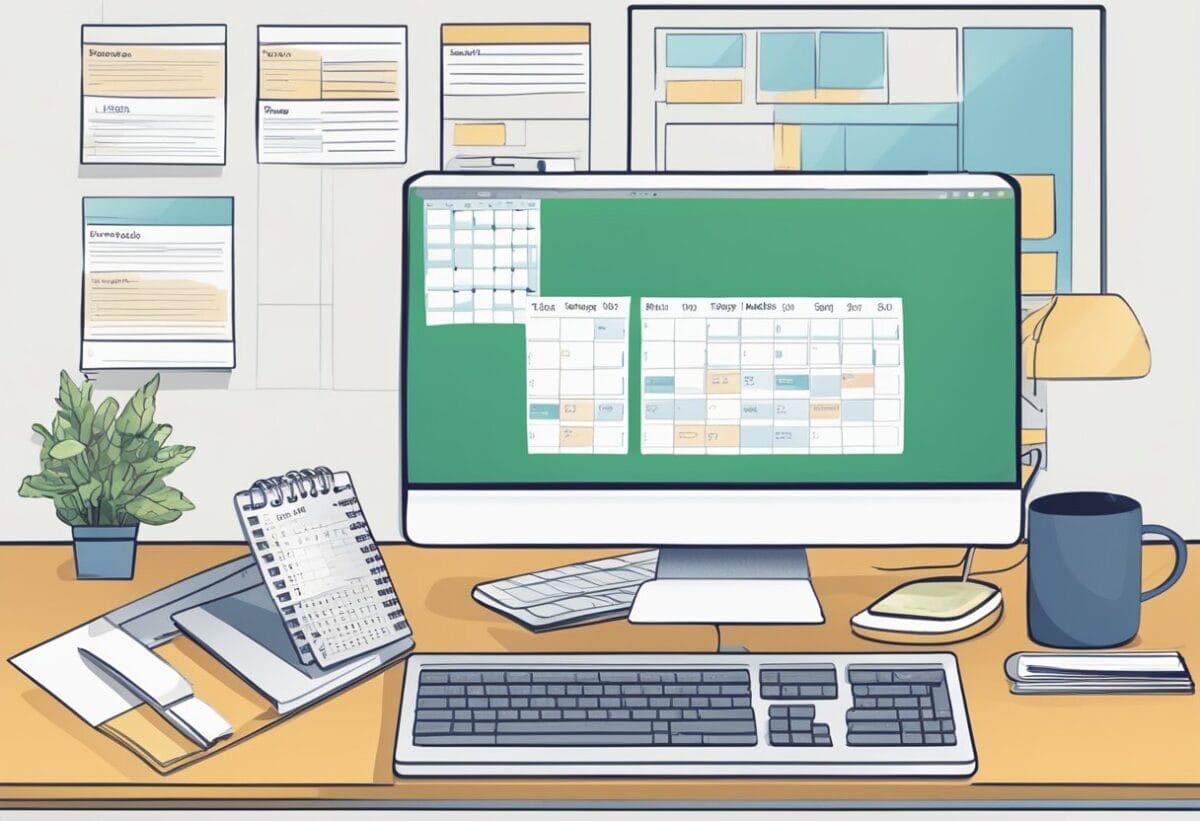Preparing for job interviews can be stressful, especially when facing tricky questions about your work habits. One common question that often trips up candidates is “How do you prioritize your work?”
You might mention using to-do lists, time management tools, or prioritization methods like the Eisenhower Matrix.
To answer this question effectively, focus on describing a systematic approach to managing tasks and deadlines.

When answering, give a brief overview of your process and then provide a specific example of how you’ve successfully prioritized tasks in the past. This shows the interviewer that you have practical experience in managing your workload and can adapt to changing priorities.
It’s important to show that you can handle multiple responsibilities while meeting deadlines and producing quality work.
Key Takeaways
- Prepare a clear system for prioritizing tasks to impress interviewers
- Use real-life examples to demonstrate your prioritization skills
- Show flexibility in handling multiple projects and changing deadlines
Why Do Employers Ask ‘How Do You Prioritize Your Work?’
Employers ask this question to learn about your organizational skills. They want to know if you can handle multiple tasks and deadlines.
Your answer shows how you manage your time and responsibilities. It gives insight into your work style and efficiency.
Employers also use this question to assess your:
- Communication skills
- Ability to handle pressure
- Alignment with company culture
They’re looking for candidates who can:
- Meet deadlines
- Adapt to changing priorities
- Work independently
Your response can reveal how you’d fit into their team. It shows if you can handle the job’s demands and requirements.
This question helps reduce interview anxiety. It lets you talk about your strengths and experiences.
Employers want to see your confidence in managing workloads. They’re interested in how you approach challenges and make decisions.
Your answer can demonstrate your:
- Problem-solving abilities
- Self-awareness
- Initiative
While there’s no perfect way to prioritize, employers want to see that you have a thoughtful approach that works for you and can benefit their organization.
Common Variations Of ‘How Do You Prioritize Your Work?’

Interviewers may ask about work prioritization in different ways. Here are some common variations:
- “What happens when you have two priorities competing for your time?”
- “How do you handle multiple tasks with conflicting deadlines?”
- “Can you describe your time management strategy?”
You might also encounter these questions:
- “How do you decide which tasks are most important?”
- “What tools or methods do you use to organize your work?”
- “Tell me about a time you had to juggle multiple projects.”
Employers want to know how you:
- Assess task importance
- Manage your time effectively
- Handle stress and pressure
- Adapt to changing priorities
Be ready with specific examples from your past work. Show how you’ve successfully managed competing demands.
There’s no single right answer, in this interview question, the key is to demonstrate your thoughtful approach to work organization.
Practice your response to these variations. You’ll feel more confident in your interview.
Guide On How To Answer ‘How Do You Prioritize Your Work?’

Mastering work prioritization is key to success in any job. By following these steps, you’ll showcase your organizational skills and impress your interviewer with your ability to manage tasks effectively.
Step 1: Know What Method You Use
Start by explaining your method for assessing tasks. Look at each item on your to-do list and evaluate its urgency and importance. Use tools like the Eisenhower Matrix to sort tasks into four categories:
- Urgent and important
- Important but not urgent
- Urgent but not important
- Neither urgent nor important
This system helps you focus on what truly matters. Mention that you always tackle urgent and important tasks first.
Step 2: Show You Method Briefly
Discuss how you set clear goals and deadlines. Break larger projects into smaller, manageable tasks. Assign each task a specific deadline to keep yourself accountable.
Use project management tools like Trello or Asana to track progress. These platforms help you visualize your workload and adjust priorities as needed.
Remember to stay flexible. Priorities can change quickly, so be ready to adapt your schedule when necessary.
Step 3: Demonstrate Your Capability
Explain how you manage your time effectively. Use time blocking to dedicate specific hours to certain tasks. This technique boosts your focus and productivity.
Create a daily and weekly schedule. Start each day by reviewing your tasks and adjusting your plan if needed. End each week by preparing for the next one.
Mention that you minimize distractions during focused work time. Turn off notifications and find a quiet space to maximize efficiency.
Step 4: Highlight Skills
Highlight your communication skills. Discuss how you keep your team and stakeholders informed about your progress and priorities. Regular check-ins ensure everyone is on the same page.
If you’re dealing with conflicting priorities, explain how you’d approach the situation. Talk to your manager or team members to clarify which tasks take precedence.
Show that you’re a team player by mentioning how you balance your work with helping colleagues when needed.
Step 5: Link it Back Together
Emphasize your commitment to continuous improvement. Regularly review your prioritization methods and look for ways to become more efficient.
Track your productivity and identify areas where you can streamline your processes. Be open to feedback from colleagues and managers on how to improve your work prioritization.
Mention stress management techniques you use to stay calm under pressure. This shows you can handle a heavy workload without sacrificing quality or burning out.
Best Example Answers To ‘How Do You Prioritize Your Work?’

Giving strong answers about work prioritization shows your organizational skills and ability to manage time well. Here are some examples tailored to different career stages and situations.
Example Answer For A Recent Graduate
“As a recent graduate, I use a mix of digital tools and old-school methods to stay on top of my work. I start each day by making a to-do list, ranking tasks by urgency and importance. I use my phone’s calendar app to set reminders for deadlines.
For big projects, I break them down into smaller, manageable steps. This helps me track progress and avoid feeling overwhelmed. I also set aside time for unexpected tasks that may come up.
I learned these skills during my internship, where I had to juggle multiple assignments. It taught me to be flexible and adjust my priorities when needed.”
Example Answer For An Experienced Candidate
“With years of experience, I’ve refined my prioritization process. I use the Eisenhower Matrix to sort tasks into four categories: urgent and important, important but not urgent, urgent but not important, and neither urgent nor important.
I tackle the urgent and important tasks first. For the important but not urgent ones, I schedule dedicated time blocks. I delegate or streamline the urgent but not important tasks where possible.
I also keep open communication with my team and managers. This helps me stay aligned with company goals and adjust my priorities if needed. Regular check-ins ensure I’m always working on what matters most.”
Example Answer For Applying For A Leadership Position
“As a leader, prioritizing work isn’t just about managing my tasks, but also guiding my team’s focus. I start by aligning our priorities with the company’s strategic goals. Then, I use a combination of urgency and impact to rank tasks.
I hold weekly team meetings to review our priorities and progress. This keeps everyone on the same page and allows us to adjust quickly if needed. I also encourage my team to speak up if they’re struggling with their workload.
I believe in leading by example, so I’m transparent about my own prioritization methods. This fosters a culture of open communication and efficient time management across the team.”
Example Answer For An Industry Change
“Changing industries has taught me the importance of adaptability in prioritizing work. I start by understanding the new industry’s pace and key performance indicators. Then, I align my priorities accordingly.
I use a combination of to-do lists and project management software to keep track of tasks. I rank them based on their impact on my learning curve and contribution to the team’s goals.
I’m not afraid to ask questions or seek guidance from more experienced colleagues. This helps me understand the relative importance of different tasks in my new industry context.”
Example Answer For A Career Change
“Changing careers has made me approach work prioritization with fresh eyes. I start each week by listing my tasks and categorizing them into ‘must-do’, ‘should-do’, and ‘nice-to-do’.
I focus on tasks that help me learn and grow in my new role. I use the Pomodoro Technique to manage my time, especially for challenging tasks in unfamiliar areas.
I also make sure to allocate time for networking and relationship-building. These connections often provide valuable insights that help me prioritize more effectively in my new field.”
Join over 11,000+ achievers who are committed to achieving their career goals!






